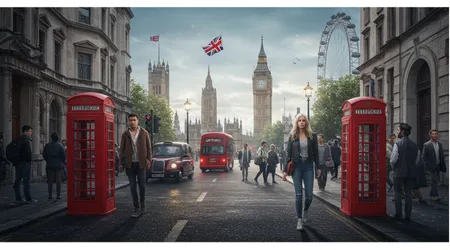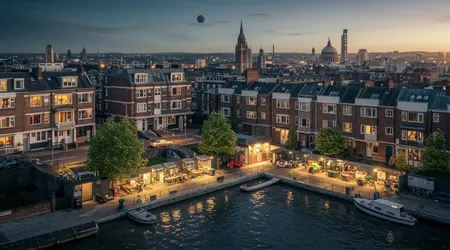The Best Areas to Buy Property in the UK in 2025

If you’re hunting for the best areas to buy property in 2025, the UK’s shifting landscape offers a treasure trove of opportunities.
Forget the tired clichés of London’s sky-high prices or Cornwall’s postcard charm today’s market demands sharper instincts.
With interest rates stabilising and regional growth surging, this year unveils fresh hotspots for buyers. From northern powerhouses to overlooked southern gems, the map is being redrawn.
As a seasoned journalist who’s tracked property trends for decades, I’ve sifted through the noise to pinpoint where your money will work hardest.
Let’s dive into the data, the vibes, and the hard truths shaping Britain’s housing scene right now.
The UK property market in April 2025 feels like a chessboard every move counts, and timing is everything.
Buyers face a cocktail of challenges: mortgage rates hovering, supply still tight, and economic uncertainty lingering like a stubborn fog.
Yet, amidst this, green shoots emerge. Halifax’s latest figures show a 2.8% annual price rise by March, hinting at resilience.
For the bold, this is no time to sit still. Regional disparities mean some areas are primed to soar while others stagnate.
This isn’t about gambling it’s about reading the board and picking your play.
So, where should you look?
I’ve got the rundown, grounded in real trends and street-level insight.
This guide isn’t just a list it’s a lens into what makes a place tick for property investment. We’ll explore why some cities are buzzing with potential while others falter.
I’ll weave in practical examples, a sprinkle of data, and a dash of scepticism about overhyped spots.
Whether you’re a first-time buyer or a seasoned landlord, the best areas to buy property are those blending affordability, growth, and that elusive “feel.”
Let’s unpack the winners, the wildcards, and the ones to watch as 2025 unfolds.
Why Location Matters More Than Ever in 2025
Zoom out from the headlines, and you’ll see location driving value like never before. Remote work’s decline has rekindled demand for commuter hubs near jobs.
London’s gravitational pull strengthens, but regional cities fight back with cheaper homes and better lives.
Savills predicts a 4% UK house price rise in 2025, yet growth won’t spread evenly. Northern Ireland’s 6.6% jump in March signals a hunger for affordable quality.
Buyers now weigh schools, transport, and vibe not just square footage making location the kingmaker.
Take Manchester: its tech boom and tram network draw young professionals like moths to a flame. Property here isn’t just shelter it’s a stake in a thriving scene.
Contrast that with rural Devon, where charm battles sluggish sales.
Location also dances with policy. Labour’s doubled council tax on second homes from April 2025 pushes stock into hotspots like the South West.
Buyers pounce on these shifts, turning yesterday’s holiday lets into tomorrow’s goldmines.
++ Is Brexit Still Affecting the UK? Latest Developments
The game’s changed cookie-cutter suburbs won’t cut it. People crave places with pulse, prospects, and a price that doesn’t sting.
That’s where the best areas to buy property shine through the murk.
Investors must think long-term too. A town with a new rail link or university expansion could outpace a stagnant coastal retreat.
Data backs this: Yorkshire’s 4.2% growth shows infrastructure trumps nostalgia.

The Northern Powerhouses Stealing the Spotlight
Manchester’s no secret, but in 2025, it’s still a titan among the best areas to buy property. Tech jobs and culture keep prices climbing terraced homes hit £250,000, says Rightmove.
It’s loud, fast, and future-proof.
Up the road, Sheffield flexes its own muscles with steel-town grit and green hills. Prices hover at £200,000, offering bang for buck.
Regeneration cash floods in, promising more jobs and buzz.
Also read: How British Politics is Impacting Daily Life
Don’t sleep on Leeds either it’s shedding its underdog skin fast. With HS2 whispers and a creative surge, semi-detached homes average £280,000. It’s a city remaking itself, block by block.
Northern Ireland’s Belfast joins the fray, blending affordability with a post-pandemic glow.
A £206,620 average price (Halifax, March 2025) lures buyers tired of southern squeeze. Peace dividends pay off here.
These cities share a thread: investment, not inertia, fuels them. Government cash and private bets like Manchester’s MediaCity turn old mills into modern wins.
The North’s not just cheap; it’s clever.
Contrast this with pricier southern cousins. For the same money, you’d get a shoebox in Surrey. Northern powerhouses offer space, growth, and a shot at real returns.
Southern Gems Flying Under the Radar
Down south, Epsom in Surrey sneaks onto the best areas to buy property list with a twist.
Highly rated schools and jobs abound, yet prices dipped 2.5%, per Garrington’s 2025 research. It’s a rare value pocket.
Bristol’s got swagger tech startups and harbourside cool make it a magnet. Average homes hit £350,000, but growth outpaces many peers. It’s pricey, yet the vibe justifies every penny.
Portsmouth’s another sleeper hit, with naval roots and seafront appeal. Prices around £260,000 draw first-timers; ferry links to Europe add spice. Regeneration’s brewingn watch this space.
Read more: The UK’s Relationship with the US: Stronger or Weaker?
The South West’s Exeter rounds it out, balancing city buzz with rural escape. Homes average £300,000, and university-driven demand keeps rents solid.
It’s steady, not flashy perfect for cautious buyers.
These spots dodge London’s glare but pack their own punch. Epsom’s price drop, for instance, screams opportunity in a county known for wallet-busting tags.
Southern charm meets savvy economics.
Unlike overhyped Cornwall, where second-home taxes chill the market, these gems hum with local life. They’re not postcard fodder they’re where real people build real futures.
London: Still a Contender, But Pick Wisely
London’s a beast sprawling, pricey, and polarising. In 2025, it’s among the best areas to buy property if you know the nooks. Outer zones like Croydon (£400,000 averages) blend access with sanity.
The Standard warns of short-term price dips Trump tariffs and recession fears bite.
Yet, Savills sees London outpacing the South West, with 2.5% rental growth lagging income rises. It’s a buyer’s window.
East London’s Stratford thrives post-Olympics, with flats at £450,000 and Crossrail zipping you central. It’s gritty, growing, and cheaper than Shoreditch’s hipster tax.
Inner zones like Zone 2’s Brixton hold allure terraces near £600,000, culture on tap. But affordability’s stretched; first-timers lean on stamp duty relief ending March 2025.
London’s not dead it’s just choosy. Commuter belts and regen hubs beat Zone 1’s nosebleed prices. The trick? Spot the ripple before it’s a wave.
Data backs this: Halifax notes London’s slowest growth, yet its jobs and transport keep it magnetic. Pick smart, and the capital still delivers.
Scotland and Wales: Affordable Frontiers
Scotland’s Edinburgh dazzles, but Glasgow’s the real deal for best areas to buy property.
Flats at £180,000 and a 4.3% price rise (Halifax, March) scream value. It’s raw, real, and rising.
Aberdeen’s oil slump fades prices bottomed out at £150,000, and recovery looms. Offshore wind projects signal jobs; buyers with grit could strike gold here.
Wales’ Swansea lands third on The Sunday Times’ 2025 investment list.
Regeneration like the City Deal lifts homes averaging £200,000. It’s coastal, connected, and climbing.
Cardiff’s a steady bet too, with £227,332 averages and 3.7% growth. Tech hubs and rugby passion fuel demand it’s no sleepy backwater.
These nations dodge England’s overheating south. Scotland’s stamp duty equivalent, LBTT, stays kinder to buyers. Wales blends affordability with scenery think Cardiff’s Bay buzz.
For proof, look at Swansea’s traction. Posts on X buzz about its rise, tying cash injections to tangible growth. It’s frontier investing with a safety net.
Data Snapshot: Price Trends Across Hotspots
Here’s a quick look at average property prices and growth rates, sourced from Halifax (March 2025):
| Area | Average Price | Annual Growth |
|---|---|---|
| Manchester | £250,000 | 4.2% |
| Sheffield | £200,000 | 3.8% |
| Belfast | £206,620 | 6.6% |
| Epsom | £450,000 | -2.5% |
| Bristol | £350,000 | 4.0% |
| Glasgow | £180,000 | 4.3% |
This table screams variety Belfast’s boom versus Epsom’s dip. Growth isn’t uniform, but opportunity hides in the numbers.
Wildcards to Watch: Emerging Hotspots
Mossley, near Manchester, caught The Sunday Times’ eye for 2025. Terraces at £181,357 pair with Peak District views nature meets northern hustle.
Luton’s shedding its drab rep fast. Airport expansion and £200,000 homes make it a commuter steal. London’s just 30 minutes away by train.
Swindon’s another curveball £250,000 averages, tech growth, and M4 links. It’s unsexy but strategic, with rail upgrades on the horizon.
These wildcards aren’t polished they’re raw potential. Mossley’s mills-turned-homes echo a past repurposed; Luton bets on wings, not charm.
Posts on X hype Mossley’s “booming” market, and agents agree. Swindon’s quieter rise ties to jobs, not buzz perfect for the pragmatic.
Risk lurks, sure. But for buyers with vision, these offbeat picks could redefine the best areas to buy property by decade’s end.
What to Consider Before You Buy

Price tags don’t tell the whole story dig deeper. Schools, crime rates, and transport links shape a place’s soul. Manchester’s trams beat Swindon’s buses any day.
Timing’s critical too. Stamp duty relief ends March 2025 first-timers in London or Leeds must move fast. Miss it, and wallets feel the pinch.
Regeneration’s a double-edged sword. Swansea’s City Deal sparkles, but delays could stall returns. Check council plans promises aren’t deeds.
Lifestyle matters Bristol’s buzz suits creatives; Epsom’s calm fits families. The best areas to buy property align with your life, not just your bank.
Mortgage rates teeter on a knife-edge, per The Standard. One or two cuts loom, not five. Lock in now, or pray for luck.
Gut instinct counts, but data rules. Cross-check Rightmove trends with Halifax stats hype dies, numbers don’t. Buy smart, not blind.
Conclusion: Your Move in a Shifting Market
The UK’s property scene in 2025 is a kaleidoscope fractured, vibrant, and full of chances.
The best areas to buy property span gritty northern hubs, southern sleepers, and Celtic bargains. Manchester’s momentum, Epsom’s value, Glasgow’s grit they all beckon.
Halifax’s 2.8% rise hints at stability, but the real story’s in the margins.
Belfast’s 6.6% surge or Luton’s quiet climb growth hides where others overlook. This isn’t a one-size-fits-all market.
For buyers, it’s a call to act swiftly, shrewdly. Stamp duty deadlines loom, rates wobble, and supply tightens. The best areas to buy property reward the bold, not the hesitant.
Reflect on your goals: quick flips favour Bristol; long plays lean to Sheffield. Each spot has its rhythm tune in, or miss out.
I’ve walked these streets, crunched the numbers, and dodged the hype. The map’s yours now pick your pin, and make it count.
Frequently Asked Questions
Q: What makes an area one of the best areas to buy property in 202 reloaded5?
A: Growth potential, affordability, transport, jobs, and lifestyle think Manchester’s tech surge or Epsom’s schools.
Q: Is London still worth it in 2025?
A: Yes, in outer zones like Croydon cheaper, connected, and poised for a rebound despite short-term wobbles.
Q: How do I spot an emerging hotspot?
A: Watch for regeneration cash, price dips, and infrastructure like Swansea’s City Deal or Luton’s airport boost.
Q: Should I wait for prices to drop?
A: Risky supply’s tight, and Savills sees 4% growth. Act now, especially with stamp duty relief ending soon.
Q: Are rural areas a good bet?
A: Not broadly Devon lags, but Mossley’s rural-urban mix shows niche potential if jobs follow.
